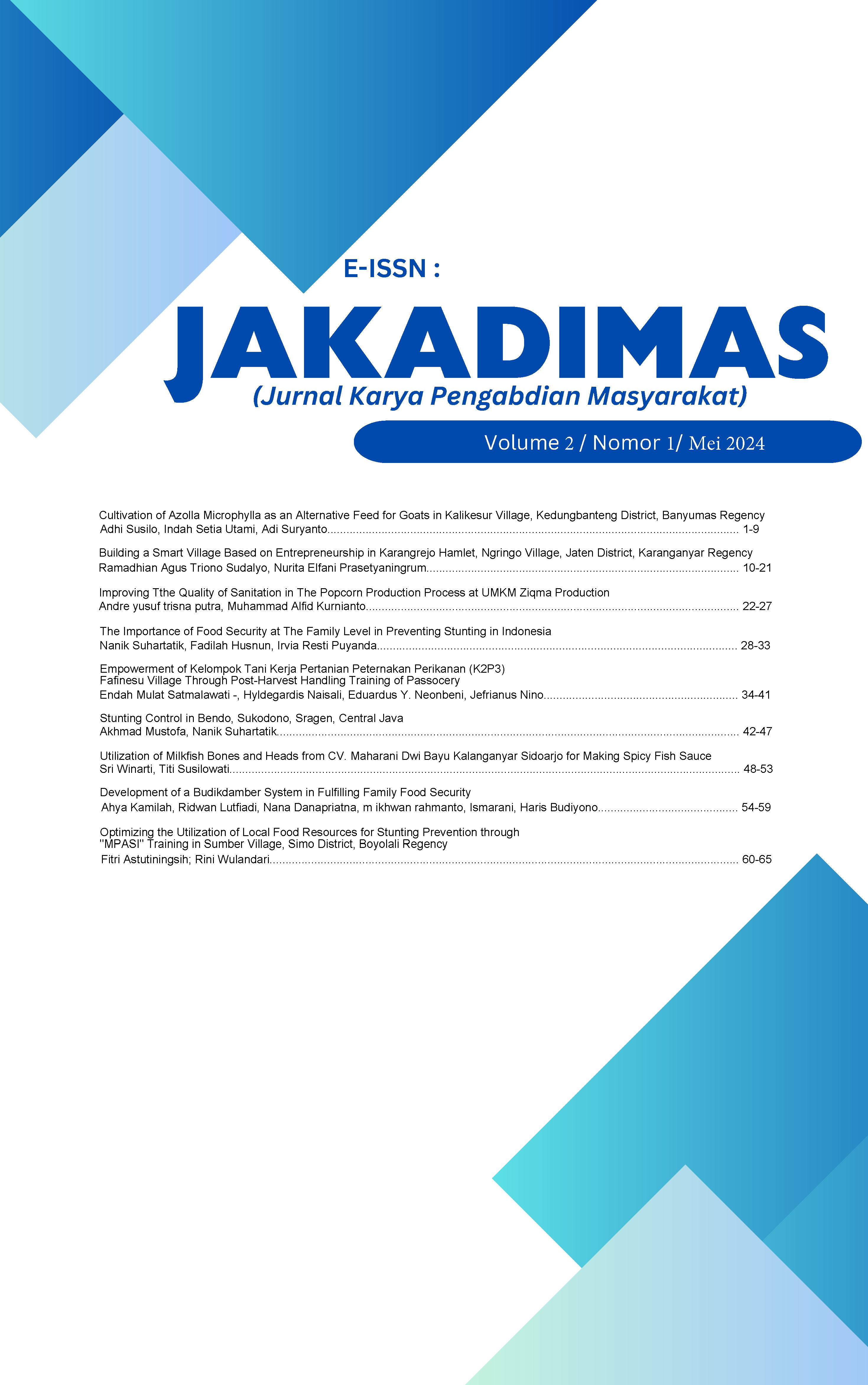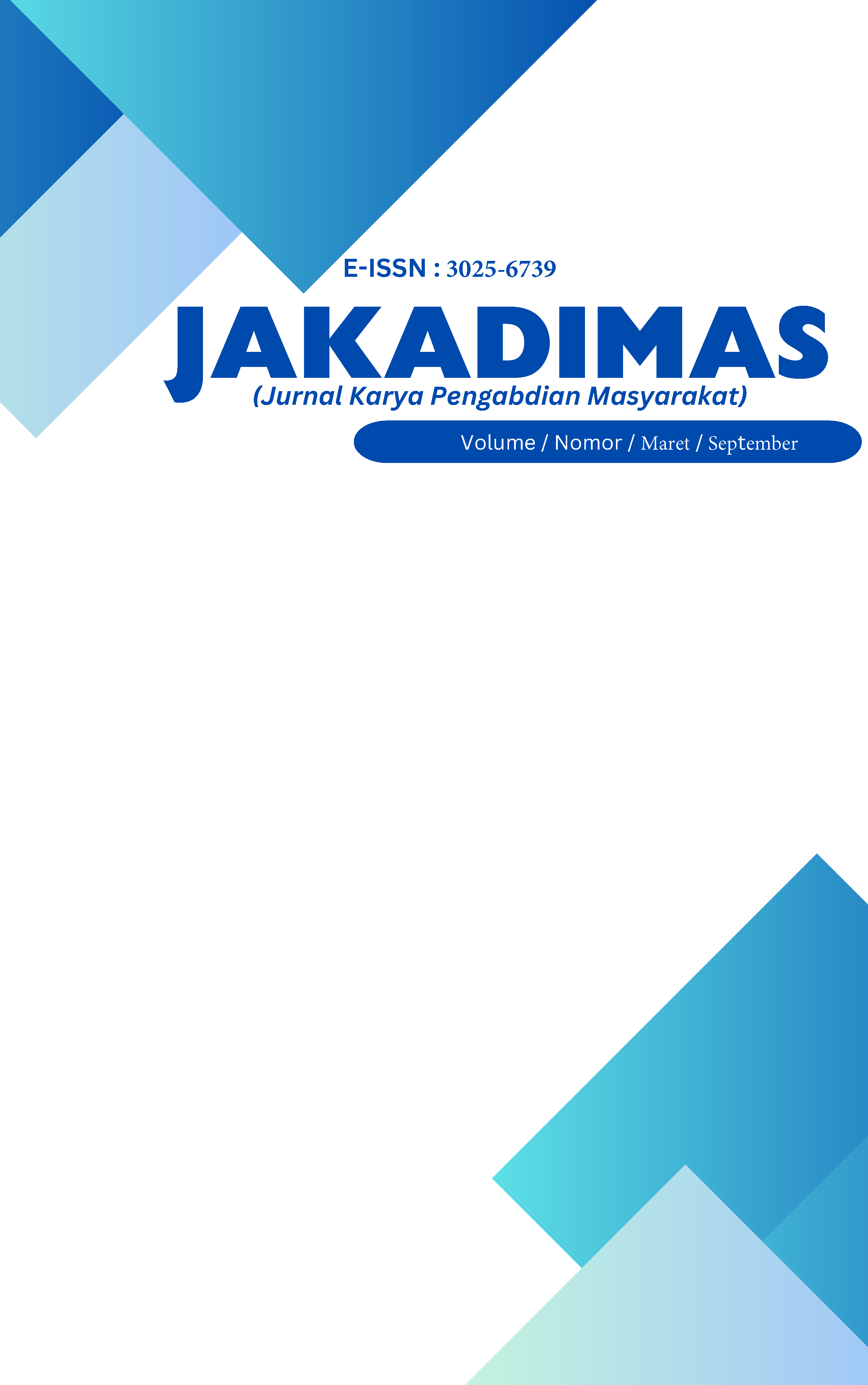Empowerment of Kelompok Tani Kerja Pertanian Peternakan Perikanan (K2P3) Fafinesu Village Through Post-Harvest Handling Training of Passocery
Pemberdayaan Kelompok Tani Kerja Pertanian Peternakan Perikanan (K2P3) Desa Fafinesu Melalui Pelatihan Penanganan Pascapanen Buah Markisa
DOI:
https://doi.org/10.33061/jakadimas.v2i1.10756Keywords:
Fafinesu Village, K2P3, passion fruit, instant passion fruitAbstract
Fafinesu Village is one of the villages in Kecamatan Insana tengah, Kabupaten Timor Tengah Utara (TTU) NTT which has been involved in horticulture cultivation, especially passion fruit, on a fairly large land area. Passion fruit plants are cultivated together with other horticulture such as papaya and vegetables (tomatoes and chilies). The large amount of passion fruit harvested by Kelompok Tani Kerja Pertanian Peternakan Perikanan (K2P3) which was formed in 2020 in Fafinesu Village has not been utilized optimally and its economic value is not yet visible. Knowledge of post-harvest handling of passion fruit is not widely known by the public. Passion fruit business opportunities are still quite wide open because of marketing opportunities. However, one of the factors that is an obstacle to developing passion fruit is post-harvest technology which is not yet known to farmers. This community service program aims to increase farmers' knowledge and skills in post-harvest handling of passion fruit in order to increase the economic value of passion fruit. One product that is long-lasting is using a high sugar concentrate, so training was carried out in making an instant passion fruit drink combined with the medicinal rhizome plant (turmeric) to become a traditional turmeric and passion fruit sour drink product. The method used in this activity is practice and assistance in processing passion fruit. Community service was successful thanks to the active participation of farmer groups by producing new passion fruit processing products in the form of traditional instant drinks. The knowledge and skills of farmer groups increase and will ultimately have an impact on increasing production and the economy
References
Aini, N., & Setyaningsih, D. N. (2018). Pengaruh konsentrasi gula sukrosa terhadap kualitas minuman instan dari sari bit merah (Beta vulgaris L). Jurnal Kompetensi Teknik, 10(2):9-13
Kusuma Wardhani, A., Mustofiyah, A., Widyanengrum, A., & Mukaromah, A. H. (2019). Pemanfaatan Buah Markisa (Passiflora edulis) sebagai Upaya Penangan Cemaran Ion Cr (VI) Pada Kerang Hijau (Perna viridis Linn). Prosiding The 10th University Research Colloqium 2019 Sekolah Tinggi Ilmu Kesehatan Muhammadiyah Gombong: 782-787
Mulyani T, Yulistiani, & Nopriyanti M. (2014). Pembuatan Bubuk Sari Buah Markisa Dengan Metode “Foam-Mat Drying†(The Making Markisa Juice Powder using Foam Mat Drying Method).Jurnal Reka Pangan,8 (1):22-38
Selly Laia, W. R., & Herawati Oktavianty. (2023). Karakteristik Antioksidan dan Organoleptik Minuman Teh Telang dengan Penambahan Sari Buah Markisa. Agroforetech, 1(2):1097-1106
Susanti, Y. I., Dwi, W., & Putri, R. (2014). The Making of Passion Red (Passiflora edulis f. edulis Sims) Powder (Concern Study on Tween 80 and Drying Temperatur). Jurnal Pangan dan Agroindustri,2(3):170-179.
Viera, W., Shinohara, T., Samaniego, I., Sanada, A., Terada, N., Ron, L., Suárez-Tapia, A., & Koshio, K. (2022). Phytochemical Composition and Antioxidant Activity of Passiflora spp. Germplasm Grown in Ecuador. Plants, 11(3):1-19. https://doi.org/10.3390/plants11030328
Sudjatha W. (2017). Fisiologi dan Teknologi Pascapanen. Buku Ajar. Udayana University Press: 42-60
Yudo Leksono, B., & Kianto Atmodjo, P. (2022). Pengolahan Sirup dan Selai Markisa oleh Kelompok Tani Kampung Markisa untuk Memasuki Era. Jurnal Media Abdimas , 1(3), 34–40. https://doi.org/10.37817/mediaabdimas.v1i3
Downloads
Published
How to Cite
Issue
Section
License
Copyright (c) 2024 Endah Mulat Satmalawati -, Hyldegardis Naisali, Eduardus Y. Neonbeni, Jefrianus Nino

This work is licensed under a Creative Commons Attribution-ShareAlike 4.0 International License.
Authors who publish with this journal agree to the following terms:
- Copyright on any article is retained by the author(s).
- The author grants the journal, right of first publication with the work simultaneously licensed under a Creative Commons Attribution License that allows others to share the work with an acknowledgment of the work’s authorship and initial publication in this journal.
- Authors are able to enter into separate, additional contractual arrangements for the non-exclusive distribution of the journal’s published version of the work (e.g., post it to an institutional repository or publish it in a book), with an acknowledgment of its initial publication in this journal.
- Authors are permitted and encouraged to post their work online (e.g., in institutional repositories or on their website) prior to and during the submission process, as it can lead to productive exchanges, as well as earlier and greater citation of published work.
- The article and any associated published material is distributed under the Creative Commons Attribution-ShareAlike 4.0 International License








